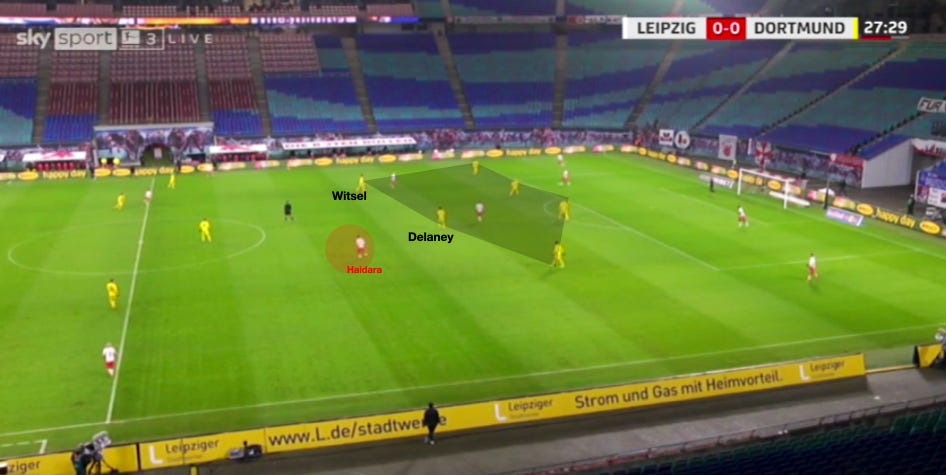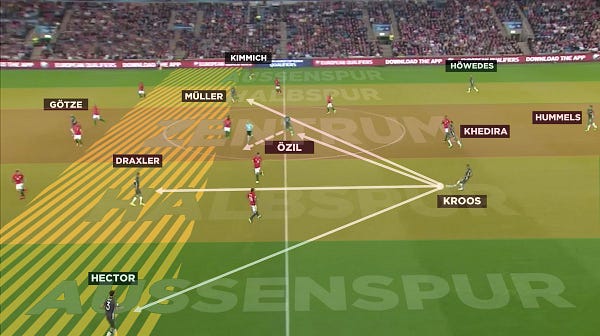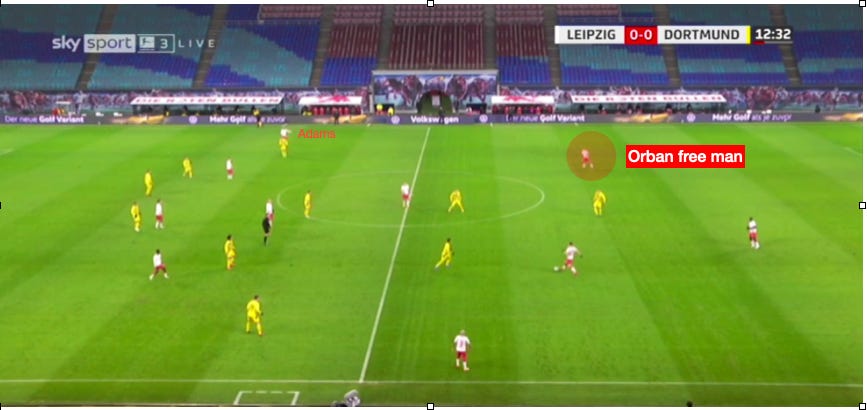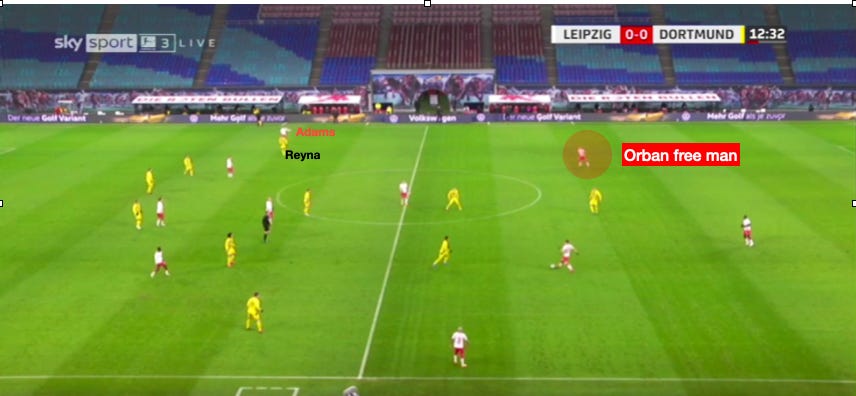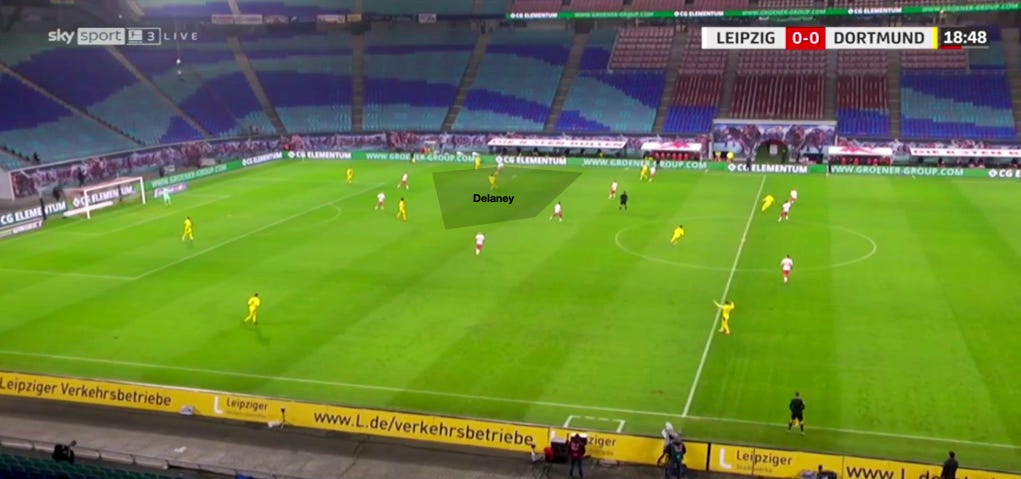Match analysis : 1st half of RBL-BVB
why 45 minutes producing 0.06 xG is worth watching again and again
Having provided some historical, stylistic and emotional context, let’s take this over to the match analysis side of things and break down the first half. Admittedly on the surface, the first 45 offered little in the way of output, given that there were a combined 3 shots (all by the home side) for 0.06 xG. But why did we see just 3 shots and 1 on target in the first half?
First, I’ll take a look at Leipzig’s approach to dominate the match, how they went about building up and creating chances via Angelino and Dani Olmo. Second, we’ll look at how BVB sought to negate this approach via their pressing. This part will zoom in on two key actors, Willi Orban who was often the free man (why this was the choice by BVB will be explained) and Gio Reyna’s difficult defensive assignments. Then, we’ll finish off by Leipzig’s pressing vs Dortmund’s buildup and why BVB struggled.
Leipzig’s ideas with the ball vs Dortmund’s defensive plan:
Free Willi (Orban), go go Gio and when will the press arrive?
When in possession, Leipzig adhered to the principles of Juego de Posicion but also varied their buildup structure based on the intensity and position of Dortmund’s pressure. In general, this is partly due to Nagelsmann’s ideas on luring opponents out to press and out of their position. One reason for his back 3 is to have it as an attacking weapon to create superiority in buildup and invite the press and then once the opponent is unbalanced RBL can attack quickly and vertically through diagonal passes and wall pass layoffs + third man runs.
Against a high pressing 424 from Dortmund, Leipzig had Tyler Adams play very deep to create a 5v4 with Gulácsi joining the back 4 as a passer in an effort to stretch the first line of press. The aim was to access the halfspaces, specifically to get Dani Olmo on ball, although if Sabitzer as the 6 could rotate out of Reus’s cover shadow he would be accessed as well. There were extreme cases of BVB sending both of its DMs to create a pressing net of 6 players, which left some space to exploit behind and in front of the back four.
Whether it was Orban’s less ambitious passing, him being pressed hard or Haidara not being in the right places to receive is hard to say, but Leipzig didn’t always take advantage. To their credit, Dortmund’s press worked rather well already in the first half, before being turbocharged by Emre Can’s introduction - but we’ll get to that later.
When nothing else worked, the long ball to Poulsen from Gulácsi (a tried and tested tactic of Rangnick’s earlier Leipzig teams) to be knocked onto an inward moving Angelino mostly was the safety valve.
If Dortmund sat off, they played with 3151 formation that could look like a 3133.
In keeping with the tenets of Juego de Posicion, Leipzig focused on creating triangles, occupying the 5 different vertical zones (see Jens’ tweet) with the right amount of players, while also giving enough depth and width.
Once in the middle and final thirds the initial plan looked to to start on the right side, get to Olmo, work a switch to the very-high positioned Angelino to either finish or deliver a cutback or a cross to the box for Poulsen and co to arrive.
Of course, Dortmund were not about to just let that happen and they had their own ideas on how to stop this.
Dortmund’s pressing does not focus on Willi Orban, Reyna’s in-game education
Halstenberg v. Upamecano v. Orban aka Dortmund picks its poison
After 168 matches for RB Leipzig, it is certainly not a secret in the Bundesliga that Marcel Halstenberg is one of the exception build-up passers. They probably were aware of his diagonal passing quality at Dortmund’s 2nd team - where he played under David Wagner with Erik Durm (as striker!), “Bayern bogeyman” Jonas Hofmann, Florian Hübner, Kerem Demirbay and Marvin Bakalorz among others.
To be fair and not succumb to a version of revisionist history of “Halsti” having been some massive can’t miss prospect, lifelong BVB fan Halstenberg himself admitted in an interview that he wasn’t quite that far along in development. In fact, he moved to Dortmund II team then in the 3. Liga at age 20 from Hannover’s U19s and became a starter on Michael Frontzeck’s St. Pauli in the 2. Liga at age 22. Once at RB, he became renowned, first for his final third passes down the wing, but with Julian Nagelsmann focusing more on possession and diagonality in passing being one of his core principles, Halstenberg’s ability to break lines became a vital element:


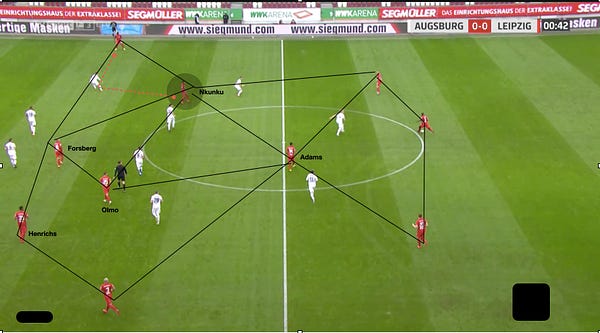


In addition to being a line-breaking passer, both Halstenberg and Dayot Upamecano are major threats to carry the ball to progress, with the Frenchman ranking 12th among the big 5 players last season for progressive distance and 14th in the total distance, and 7th and 22nd this year, per Fbref. On a per game basis that meant 438 total yards of which 247.7 were progressive for Upamecano, while Halstenberg is enjoying a career best 300 total\200 prog. yards per match this season.
SPOILER ALERT: Upamecano would finish the match with 325\196 total\prog. yards and just 58 carry attempts vs his season average of 73, while Halstenberg went for 286/186 yards. Willi Orban was already averaging career highs with splits of 299\200 and would lead Leipzig and have match-high stats in total\prog yards with 365\234.
Presumably, this is why Dortmund were much more aggressive in pressing on Halstenberg’s side and “allowed” Willi Orban to be the free man in possession. Leipzig’s occupation of the two outside zones, two halfspaces and the center with their positional play, would tie up a lot of Dortmund’s defense and meant some tough choices.
In the last line, Olmo’s great movement was the key: starting from the right halfspace he would begin drifting deep, while Adams - sometimes though not often enough for my liking - made deep runs. Olmo’s clever occupation of different zones and spaces took care of either the LB Guerreiro, but more often the left sided DM in Delaney, or sometimes both! On the left side Amadou Haidara was doing the same but mostly in the halfspace vs Witsel + at times Akanji stepping out. Generally Haidara left the outside to Angelino, who interpreted his wingback/joker role very offensively, mostly staying high, but at times coming inside to get closer to second balls from Poulsen.
That often left Willi Orban to make some plays with the ball. In the first 15-20 minutes he seemed hesitant and unwilling to dribble, but there were instances of the Hungarian taking advantage of the spaces created by Olmo’s movement and Delaney needing to follow.
One such instance came in the 24th minute,
when Orban’s penetration and pass to Haidara
got the switch from Sabitzer (could he have played in Haidara here?) to Angelino
for a decent crossing opportunity and header for Yussuf Poulsen, registering the first shot of the match in the 25th minute!
The education of Gio Reyna
One interesting side story of the first half - and you could really hear this on the audio feed that I watched it back on - was the coaching that Gio Reyna was getting from the Dortmund bench. The 18-year-old American had the undesirable task of both pressing Orban, tracking back with fellow USMNT stalwart Tyler Adams’s deep runs while also covering the inside channels in which Dani Olmo showed up in.
Here is his dilemma in the 14th minute and one can understand why Otto Addo and Edin Terzic were providing him with a lot of in-game coaching. As mentioned above, Leipzig have put a lot of pressure in front of BVB’s defense and Reyna at times was overeager to press:
Amidst the shouts of “wait, wait, wait Gio” he forges on, but is too far away to make up the ground. He does disrupt Orban enough to make the back pass to Upamecano, but the switch to Adams is an easy chip and RBL can attack Dortmund’s last line.
Tthe above images were not meant to pick on Reyna’s defense (he’s barely 18 and starting/making a difference for one of the top 15 teams in Europe) and he actually has the most pressure events for Dortmund this season with 204. However, efficiency was not his strong suit today, - as we can see from Fbref’s numbers - with the American posting a 22% success rate (he’s at 37.4 for the season) on a rather active 32 pressures.
By the way, it was a lot of fun listening to the mixed English-German instructions, praises and reactions of the BVB bench. Similarly I enjoyed Nagelsmann yelling in Spanish, “Vamos” for Dani Olmo, German for most of his players (“sichern” was a frequent cry to secure the spaces of the counterattack in rest-defense) or hearing Adams and Sabitzer discuss defensive coverage in English.
But let’s get back to pressing, after all that’s something that Leipzig are quite known for.
Leipzig in pressing, Dortmund’s possession issues with Meunier+Guerreiro and Delaney
Although during the Rangnick and certainly the Hasenhüttl years, RB were one of the Europe’s most aggressive pressing teams. They posted PPDAs (passes per defensive actions, Colin Trainor’s revolutionary metric for measuring pressing intensity) of under 7 to at its least intense a 9. Under Nagelsmann, Leipzig are not really concerned with volume, as they were at 10.5 last season and are at 8.95 PPDA this season. This was also the case with his Hoffenheim teams and where he somewhat differs from the RB style, as he prefers interceptions over duels (associated and forced by pressures).


Learning from a different, but radically successful approach (just look at all the “former” Nagelsmann players who moved on from TSG) is just one of the reasons why a progressive\smart club like RB brought him in to begin with.
At any rate, per Statsbomb\Fbref pressures in the big 5 leagues Leipzig are 24th in volume (146 per 90) but are 3rd and 4th in total successful pressures (51.6 behind Eintracht and Wolfsburg) and percentage (35.3 behind Dortmund’s 36.5%) respectively. They ranked 12th in volume (174), 2nd in successful pressures (57) and rate (32.7%) last season, but of course pressing numbers are down across the board due to COVID-19, congested schedules and decreased regeneration time.
Their pressing scheme was based on a Nagelsmann principle of preferring to have a plus one in the last line and it being a good idea to not have Haaland go 1v1 even vs Upamecano. In terms of numbers it often looked like 4132 or a diamond with Adams joining the back 3, Sabitzer sitting as the DM\6, Olmo starting in the right halfspace and pressing the LB Guerreiro, Angelino doing the same on the left. Haidara was in the ten spot pressing Witsel as the deep 6, while Forsberg joined Forsberg to press the two CBs.
Dortmund’s buildup forced wide, issues with Meunier and Guerreiro
The basic idea in this shape was to force Dortmund wide, then based on certain pressing triggers (a slow first touch, poor body position, no forward passing option, etc.) force BVB to pass inside. Those passes could then be intercepted by any one of the pressing players or the “safety” (Sabitzer below), while still making sure that Haaland was double covered.
There were also some unforced errors by Dortmund, in particular via their fullbacks. Much-maligned Thomas Meunier showed himself to be cumbersome without the ball, lacking top-speed decision-making, while also overcommitting/disconnecting himself by playing too high, though not as often as in most games this season. Here are some early scenes, where he could’ve done better:
His backwards facing body shape predetermines him to go backwards, although Angelino is rather far away and Meunier should be able to just take the ball down the line.
Other times, Leipzig’s press was helped by BVB’s structural problems, with Sancho and Meunier kind of occupying the same space here:
Sometimes, as is the case from this goal kick which Akanji received and passes over to the Beligan, there wasn’t much Meunier could do due to BVB’s disconnected structure and being forced wide. To his credit, he smartly avoided playing into Witsel and Leipzig’s trap and cleared it forwards, albeit out of bounds.
The other part of Dortmund’s buildup that didn’t succeed was on the Guerreiro\Delaney side thanks to a couple of reasons:
Poulsen doing a nice job of pressing backwards
the usually reliable and creative/progressive Guerreiro had 3-4 uncharacteristic turnovers in the first half. He would improve in the second half and lead BVB in touches, completed passes, carries, progressive distance.
We’ll get to why Guerreiro was able to be much more involved higher up the pitch in our second half analysis, but it’s telling that he and Meunier accounted for 29% of all BVB’s turnovers in the match!
The other interesting player was Thomas Delaney:
Delaney’s passing abilities/playing under pressure were never the strongest part of his game and Leipzig targeted the Dane in the first half, leading to some easy/rash turnovers
Here, he is in relatively a lot of space, but ends up just dumping it long down the wing to no one in particular.
Delaney, to his credit had his hands full with Olmo’s excellent movement and generally did a very good job of limiting the Spaniard, but perhaps paid the price on the other end with some less than stellar decisions.
In the end we saw how Dortmund’s buildup was negated by Leipzig’s press forcing some key turnovers and their own structural issues and with not much individual quality in the first 30 minutes, there was basically no offensive output. Whether or not that was the price BVB’s impact attacking players paid for an intense focus on disrupting Leipzig’s possession game by forcing Willi Orban to become the playmaker is unclear, but is a strong possibility, according to my interpretation of the match. Another theory, which I’ll seek out to prove in the next part is how Axel Witsel’s unfortunate injury became a sort of blessing in disguise for BVB, as Emre Can’s introduction became the catalyst for Borussia turning the match around early in the second half.

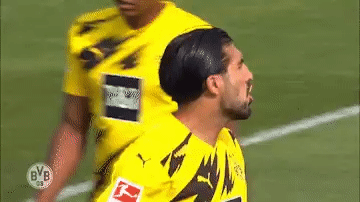
See you in the next part!
Abel




